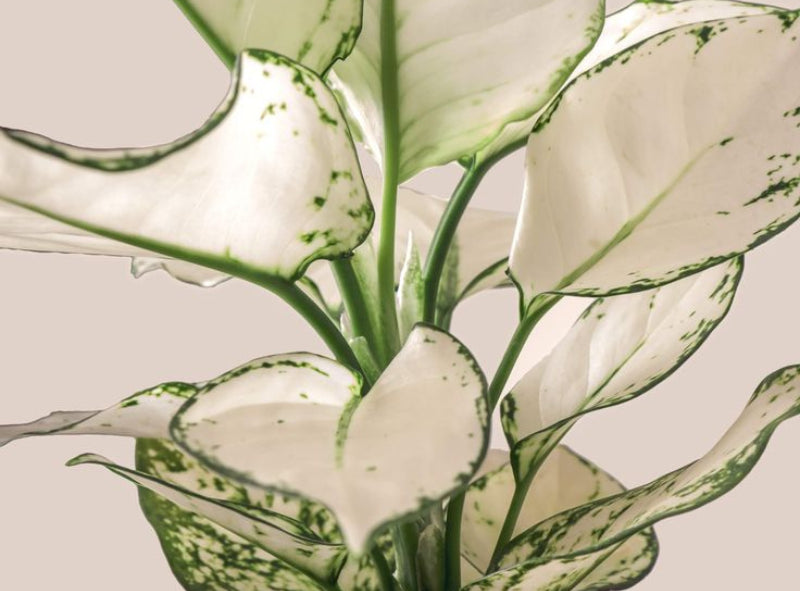- ☀️ Light
Thrives in medium indirect light, it can also tolerate low light.
- 💧 Watering
Water every 1 to 2 weeks, allowing the soil to dry out between waterings.
- 🤒 Signs of a sad plant
Wilted leaves, dry soil: lack of water
Yellowed leaves and blackened pasty base: root rot, overwatering
Greasy black spots on leaves, wilted leaves: environment too cold
- ❤️🩹 Easy to keep alive
❤️🩹❤️🩹❤️🩹❤️🩹/5
Aglaonemas are ideal plants for low light environments. This characteristic makes them perfect candidates for offices and interiors where natural light is scarce.
Indeed, their ability to adapt to low light conditions makes them extremely popular, and their relatively easy care makes them a top choice for plant lovers, whether beginners or experienced.
Why choose Aglaonemas?
Native to the humid and shady tropical forests of Asia, these plants are naturally adapted to dark environments.
Since their commercial introduction to the United States in the 1930s, they have become increasingly hardy thanks to horticultural advances. Aglaonemas are also known for being very tolerant of neglect. Meaning they can survive even if you forget to water them from time to time.. interesting. Plus, they have some ability to purify the air. Gogogo if you want to add a touch of "freshness" to your living room or office!
Aglaonemas cultivars
There are currently 24 known species of aglaonema, among the most popular, the aglaonema pictum tri-color is distinguished by its unique and colorful leaves. Each cultivar offers a different aesthetic, allowing plant lovers to choose the ones that best match their expectations and their decor.
Appearance and characteristics of leaves
The leaves of the aglaonema are their main asset. In their natural habitat, they often have variegation due to air pockets between the cell layers, creating varied color patterns. On the market, you can find aglaonema with red, white, pink, and of course, green leaves.
This diversity of colors and patterns makes aglaonemas particularly attractive to plant lovers who want to add a splash of color to their space. The leaves are not only beautiful but also hardy, able to withstand varied conditions without losing their vibrancy.
Ideal growing conditions
Light
Aglaonemas prefer indirect, moderate light . They can tolerate low light, making them perfect for dimly lit interiors. However, exposure to too much light can damage their leaves, so it is advisable to place these plants a few feet from a window or in a room that receives filtered light.
If you notice the leaves starting to discolor or burn, it may be necessary to move them to a darker location.
Temperature and humidity
These tropical plants do not like temperatures below 13°C . They thrive best in a humid environment.
To increase humidity, you can use a humidifier or place an olla in it, which will provide the perfect amount of water to your aglaonema. This porous ceramic water reservoir is very practical for plants that appreciate humidity.
In summer, make sure your plants are not exposed to cold drafts from air conditioners.
Watering
Aglaonemas require well-drained soil . An ideal mix might include peat moss, gravel, perlite, and fir bark. It is important to avoid overwatering to prevent root rot.
Water them when the soil feels dry to the touch. During the active growing months, usually spring through fall, you may need to water more frequently. In winter, reduce watering as the plants enter a dormant period 💤
Propagation of Aglaonemas
Propagation of aglaonemas can be done by division or cuttings. Individual stems can be cut and rooted in water or a light growing medium. This method makes it easy to propagate the plants.
To propagate by division, carefully remove the mother plant from the pot and separate the clumps of stems, ensuring that each division has at least three to five leaves and a healthy root system.
For cuttings, cut a section of stem just below a node and place it in a glass of water or a mixture of sphagnum moss until roots form. You can encourage rooting by adding a few drops of willow water to the water.
Common Problems and Solutions
Cold injuries
Aglaonemas are sensitive to cold temperatures, which can cause oily spots on the leaves. It is crucial to maintain a proper temperature and avoid cold drafts.
If you notice signs of cold injury, such as wilted leaves or black spots, move the plant to a warmer location as soon as possible. Trim off damaged leaves to prevent them from becoming a breeding ground for disease.


